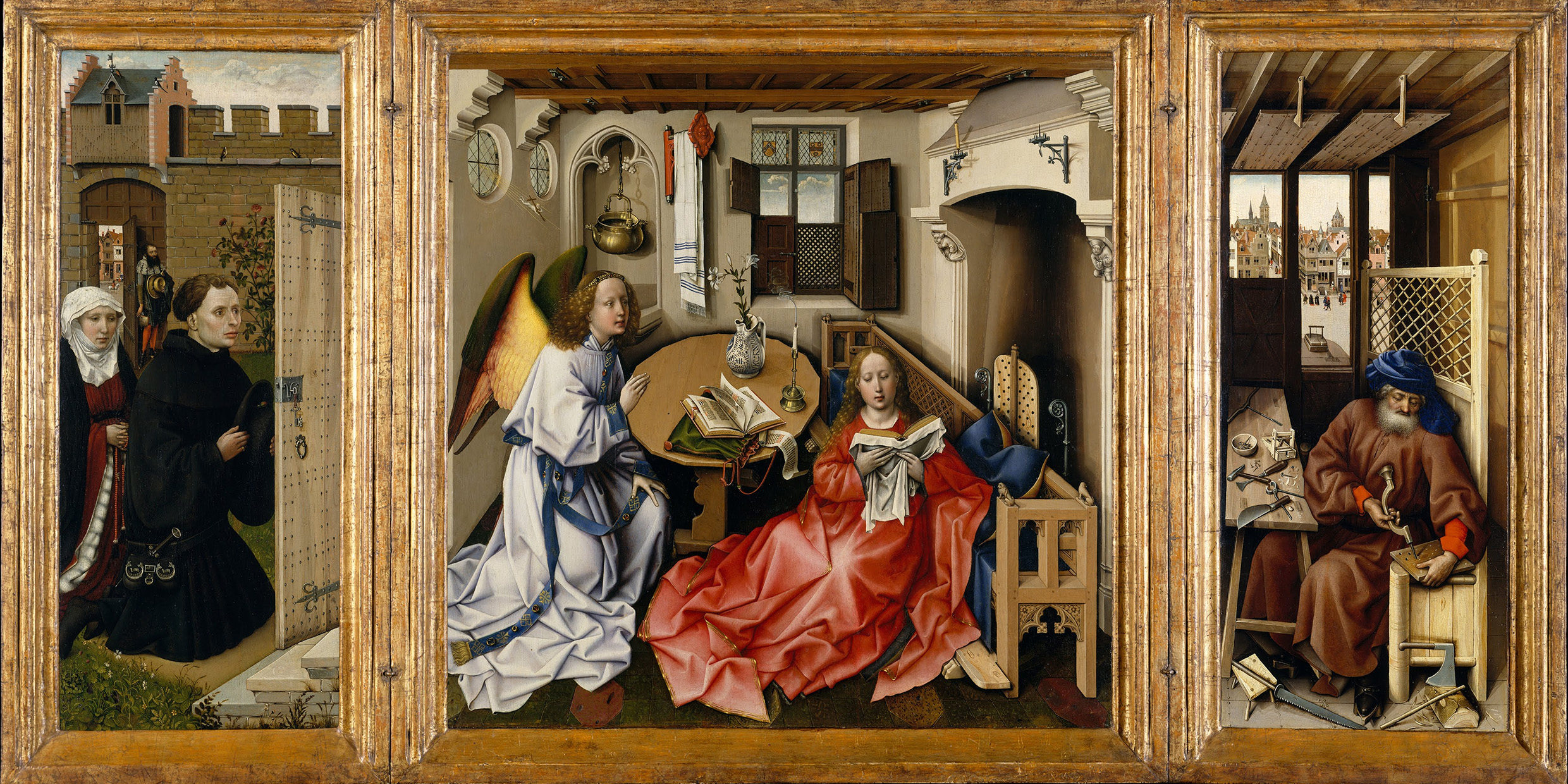Originally published 23 December 1985
I have before me on my desk a reproduction of the Mérode Altarpiece, a painting on three panels by a 15th century Flemish master believed by many scholars to be Robert Campin. The triptych depicts the moment of the Annunciation, when the angel Gabriel announces to the Virgin that she is to become the mother of Christ. It is a warm, marvelous work, rich with both cultural and religious meaning.
The left hand panel of the triptych shows a pious couple kneeling in reverence at the door of Mary’s house; it is perhaps a portrait of the donor of the altarpiece and his wife. The right hand panel presents Joseph at work in his carpentry shop. In the central panel Gabriel is about to utter the momentous words, while Mary reads, yet unawares.
This quietly unfolding drama is set in a typical 15th century Flemish household. Beyond the open door of the courtyard and the window of Joseph’s shop we are given a glimpse of the busy life of the town. It is a glimpse of Europe coming alive with commerce and technical innovation. What is most striking about the painting is the artist’s keen eye for “things,” for the mechanical accouterments of the rising middle class, and for the ways in which material goods are used to reinforce and symbolize the spiritual message.
Cusp of the Renaissance
The year is about 1430. It is the same time that Fra Angelico was painting another Annunciation, one that is medieval in its simple, ethereal setting. It is also the time that Gutenburg was beginning his experiments with movable type. In the Mérode Altarpiece we are poised on the cusp between the Middle Ages and the Renaissance, between a world of spirit and a world of matter. The angel announces a message of otherworldliness and detachment. The “things” in the painting presage the scientific and technological revolution that is about to overtake Western culture.
The master of the Mérode Altarpiece is much taken by “things.” The textures of wood, metal, cloth, and stone are lovingly rendered. Here is the carefully crafted wrought iron of the candle holders and fire irons, the gleaming brass of the hanging wash basin, and the sharp-edged steel of Joseph’s tools. Here are things the well-to-do Flemish burgher would be proud to have in his household: the fine iron lock, the lacquered wood and metal towel rack, the fine porcelain vase, the splendid carved oak settle. There are two lovingly protected books, one of them in Mary’s hands. The garments of the angel and the Virgin are rich and trimmed with gold.
On Joseph’s bench there is a clever mechanical mousetrap that gives the work its popular title, “The Madonna of the Mousetrap.” It is a “better” mousetrap, perhaps, that perennial symbol of progress and invention. With this one delightful image the artist has captured the spirit of his time: mechanical, inventive, forward-looking, preoccupied with matter and force. In the century that followed the painting of the Mérode Altarpiece, science and technology consolidated a new alliance that led directly to the Scientific and Industrial revolutions, and to a new era of material well-being for a large part of humankind.
A forgotten message
And now some would say that the Feast of Christmas has become a celebration of that very material prosperity, and that the message of the angel to the Virgin has been lost among the ample gifts which science and technology have bestowed.
I turn again to the Mérode Altarpiece. I admire the selflessness of the donor and his wife. I observe the quiet pride of Joseph in his craft. Above all, I am moved by the serene pleasure that the Virgin finds in her book. Behind her, in the porcelain vase, there are lilies, the symbol of purity of heart. The altarpiece evokes a harmony of material and spiritual concerns. In this simple household scene, rendered on a cusp of history, the Flemish master has given us a vision of two worlds in perfect balance.



